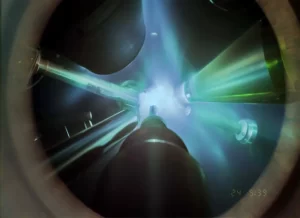Key Takeaways:
- Superionic ice, a newly discovered phase of water, challenges our understanding of the substance.
- This enigmatic form of water is black, hot, and exists under extreme pressure and temperature conditions.
- It was first theorized over three decades ago but has only now been confirmed through groundbreaking experiments.
- Superionic ice may constitute a significant portion of the water in giant icy planets like Uranus and Neptune.
- The discovery opens doors to innovative material science and sheds light on the mysterious interiors of ice giants.
In a groundbreaking experiment at the Laboratory for Laser Energetics in New York, a powerful laser was used to subject a water droplet to unprecedented pressure and temperature. The result was a first-ever glimpse into water’s behavior under conditions of millions of atmospheres and thousands of degrees. Contrary to expectations, the water atoms didn’t transform into a superheated liquid or gas. Instead, they froze into a crystalline structure, revealing a previously unknown phase of water – superionic ice.
Superionic ice, as detailed in publication, defies conventional notions of ice. Unlike the familiar ice found on Earth, it is black and hot, with a density four times greater than standard ice. This phase of water was initially predicted over three decades ago, and though it remained elusive until now, scientists speculate it might be the most prevalent form of water in the universe.

Remarkably, it is believed that superionic ice could dominate the interiors of Uranus and Neptune, surpassing liquid water found on celestial bodies like Earth’s oceans or the subsurface oceans of Europa and Enceladus. This discovery offers a potential solution to longstanding mysteries surrounding the composition of these “ice giant” planets.
Superionic ice is now identified as ice XVIII, distinguished by its unique structure. Unlike known water ices which consist of intact molecules, superionic ice exists in a state that blurs the lines between solid and liquid. Individual water molecules disintegrate, forming a cubic lattice of oxygen atoms while allowing hydrogen atoms to flow freely, resembling a liquid within the rigid oxygen framework.
This revelation not only validates long-standing computer predictions but also paves the way for material physicists to design substances with tailored properties. The experimental success required cutting-edge techniques involving ultrafast measurements and precise control of temperature and pressure, indicating a significant advancement in the field.
Experts diverge on whether to categorize superionic ice as a new phase of water or an entirely distinct state of matter due to the dissociation of water molecules. This unprecedented behavior makes it a spectacle in the realm of material science.
The quest for superionic ice began with computer simulations in 1988, proposing that water could adopt this unique metallic form under extreme conditions. These simulations envisioned water molecules breaking apart, with oxygen atoms forming a lattice while hydrogen atoms, now ionized, exhibited liquid-like movement.
However, skepticism persisted as simulations relied on approximations, and experiments struggled to generate the necessary pressures without inducing excessive heat. Coincidentally, as the concept of superionic ice emerged, the Voyager 2 probe revealed peculiarities in the magnetic fields of Uranus and Neptune, hinting at unconventional internal structures.
Recent experiments by Federica Coppari and Marius Millot, building on earlier work, have finally brought this puzzle to resolution. Using a series of precisely timed laser pulses and diamond anvils, they created super-pressurized ice and confirmed its crystalline structure through x-ray diffraction. This successful convergence of theory and experimentation signals a significant leap forward in material physics.
The implications of this discovery extend beyond our solar system. While other celestial bodies in our system may not host the conditions for superionic ice, exoplanets resembling ice giants could potentially harbor this mysterious substance. Nonetheless, it’s important to note that real planets are not composed solely of water; elements like methane and ammonia introduce further complexities.
Moving forward, the research team aims to delve deeper into the intricate behavior of superionic ice, particularly the elusive proton flow within the lattice. Despite the technological challenges, the rapid progress in this field suggests that even more revelations about this enigmatic phase of water are on the horizon.


